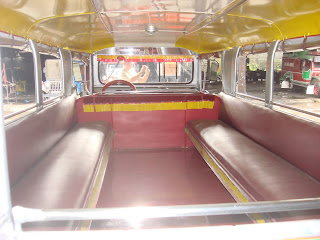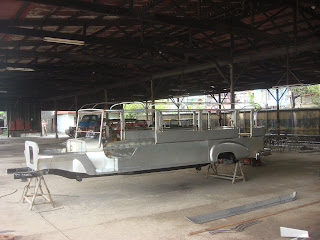
The Jeepney, as the name suggests, began after World War II when the U.S. Army started scrapping wartime jeeps. The Filipinos would take the junked vehicles and through various ingenuous ways, get it running again and use it as a taxi in post-war Manila when almost nobody had any money. As a result, these improvised taxis initially only charged the smallest coin being used by the postwar government. Today the standard rate is still only about 7 Philippine Pesos, or 18 U.S. cents.
 With time, the Filipinos began expanding the back of the jeeps to include a bed with bench seats. Today the bed frames have grown to the point where they can accommodate 25-30 people but during rush hours and after rain downpours there may be nearly twice as many. Old pictures of Jeepneys show packed beds with another ten or fifteen people hanging on the back or even the sides--dangling off the outside while holding onto a window post. You still see this once in a while, usually with kids, but the police have been discouraging the practice.
With time, the Filipinos began expanding the back of the jeeps to include a bed with bench seats. Today the bed frames have grown to the point where they can accommodate 25-30 people but during rush hours and after rain downpours there may be nearly twice as many. Old pictures of Jeepneys show packed beds with another ten or fifteen people hanging on the back or even the sides--dangling off the outside while holding onto a window post. You still see this once in a while, usually with kids, but the police have been discouraging the practice.several around Manila), there was no real factory or assembly line as you would expect in America or Japan. In fact, it looks more like a junkyard at the entrance--one section is littered with old engines, another with rear axles, and still another with suspension systems and drive trains. All Jeepneys are custom-made and the potential buyer sorts through the "junk" and chooses the power train assembly then begins designing the frame. Since the frames have extended to become small buses, the drive trains are almost always custom made from standard (usually Japanese) parts.
 The expanded frames are all similar in design but do have individual variations to the buyer's specifications. Today, most frames are made of stainless steel--which means the body will last forever and never rust--but stainless steel is very expensive and requires somebody who knows what he's doing to weld the parts. When the U.S. Navy abandoned the giant Subic Bay naval port and maintenance facility they left behind a mountain of stainless steel and that is now being used for these Jeepneys.
The expanded frames are all similar in design but do have individual variations to the buyer's specifications. Today, most frames are made of stainless steel--which means the body will last forever and never rust--but stainless steel is very expensive and requires somebody who knows what he's doing to weld the parts. When the U.S. Navy abandoned the giant Subic Bay naval port and maintenance facility they left behind a mountain of stainless steel and that is now being used for these Jeepneys.Some of the vehicles are still regular sized--the one photo shows a rebuilt one with an over sized Mercedes Benz emblem on the radiator. Others, like the solid stainless steel vehicle in the photo below it, are
 almost completely built by hand.
almost completely built by hand.Since they last forever it is not unusual to see some of the original World War II-era vehicles still running on the streets but it's nearly impossible to tell dates since everything is custom built anyway. At the "factory" there was a 1955 model on display. If you look at the fender ornaments, they should look familiar from a U.S. model in the 1950s but I can't quite remember
what they are off of.
The engines are almost all from Japan. Buyers go over there and purchase them in bulk. Usually  they are junked out engine blocks with the metric equivalent of 200,000 to 300,000 miles on them and the Filipinos rebuild the blocks from scratch and get at least that many more miles out of them. For some reason, Isuzu truck engines are very popular and most are diesel. With no effective pollution control laws in effect in Manila and the fact these have little, if any, muffling systems that means that they are constantly sending out a black plum e of diesel fumes as they go down the streets. During congestion, when twenty or thirty of them are backed up idling, it is almost impossible to breath as you walk down the sidewalk beside them.
they are junked out engine blocks with the metric equivalent of 200,000 to 300,000 miles on them and the Filipinos rebuild the blocks from scratch and get at least that many more miles out of them. For some reason, Isuzu truck engines are very popular and most are diesel. With no effective pollution control laws in effect in Manila and the fact these have little, if any, muffling systems that means that they are constantly sending out a black plum e of diesel fumes as they go down the streets. During congestion, when twenty or thirty of them are backed up idling, it is almost impossible to breath as you walk down the sidewalk beside them.
 they are junked out engine blocks with the metric equivalent of 200,000 to 300,000 miles on them and the Filipinos rebuild the blocks from scratch and get at least that many more miles out of them. For some reason, Isuzu truck engines are very popular and most are diesel. With no effective pollution control laws in effect in Manila and the fact these have little, if any, muffling systems that means that they are constantly sending out a black plum e of diesel fumes as they go down the streets. During congestion, when twenty or thirty of them are backed up idling, it is almost impossible to breath as you walk down the sidewalk beside them.
they are junked out engine blocks with the metric equivalent of 200,000 to 300,000 miles on them and the Filipinos rebuild the blocks from scratch and get at least that many more miles out of them. For some reason, Isuzu truck engines are very popular and most are diesel. With no effective pollution control laws in effect in Manila and the fact these have little, if any, muffling systems that means that they are constantly sending out a black plum e of diesel fumes as they go down the streets. During congestion, when twenty or thirty of them are backed up idling, it is almost impossible to breath as you walk down the sidewalk beside them.When the custom order is finished, it is truly a work of art but might not be for everybody's taste. They are, however, elaborate and do reflect the buyers personal preferences--as in the photo of the one with about thirty rear-view mirrors mounted on the hood along with a chrome horse.






No comments:
Post a Comment